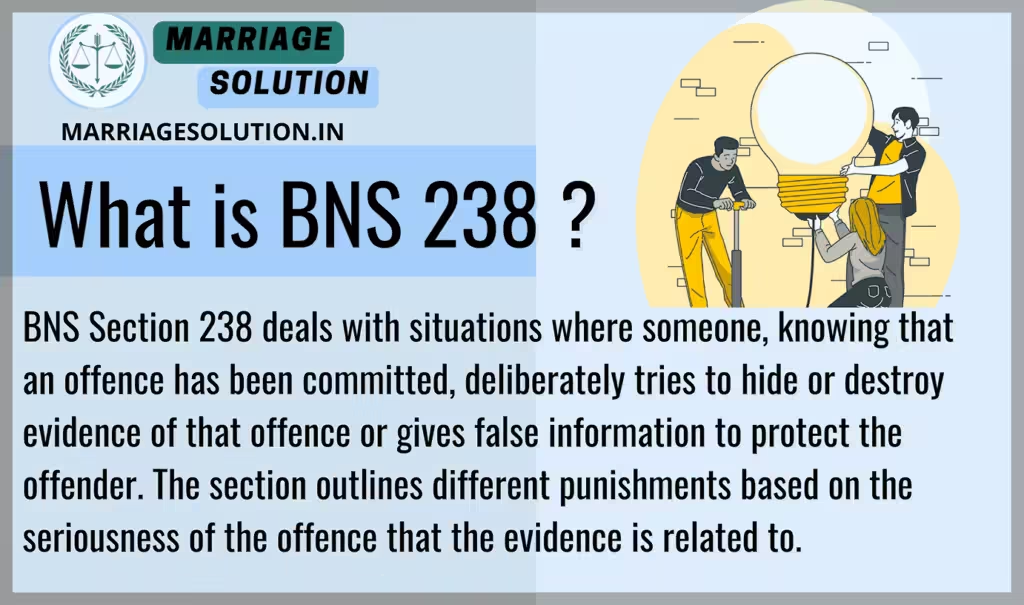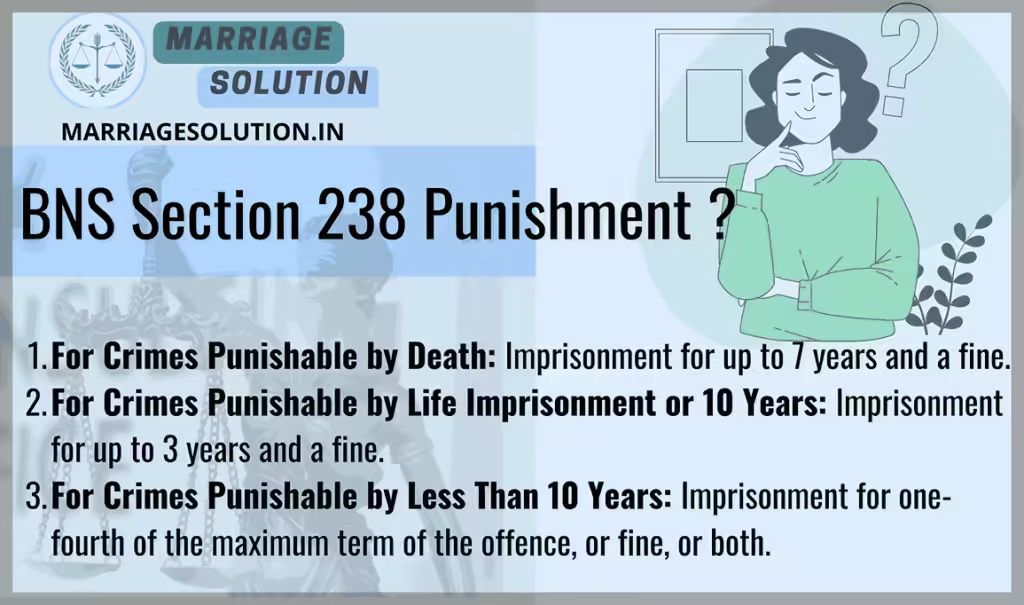Introduction of 238 BNS
238 BNS focuses on punishing individuals who deliberately hide or destroy evidence of a crime or provide false information to shield offenders. This law ensures that no one can obstruct justice by tampering with evidence or misleading authorities. The severity of the punishment depends on the seriousness of the original offence—ranging from capital crimes to lesser offences. By addressing both concealment of evidence and giving false information, this section strengthens the foundation of a fair and transparent justice system.
The Bharatiya Nyaya Sanhita (BNS) Section 238 replaces the old Indian Penal Code (IPC) Section 201.
What is BNS Section 238 ?
BNS Section 238 deals with situations where someone, knowing that an offence has been committed, deliberately tries to hide or destroy evidence of that offence or gives false information to protect the offender. The section outlines different punishments based on the seriousness of the offence that the evidence is related to.

BNS 238 in Simple Points
- Causing Disappearance of Evidence: This section applies when a person deliberately destroys or hides any evidence of an offence with the intention of protecting the criminal. For example, if a person helps someone hide a weapon used in a crime or cleans up a crime scene to erase evidence, they can be punished under this section.
- Giving False Information: If a person gives false information about a crime, knowing it is false, with the intention of helping the offender escape punishment, they are guilty under BNS Section 238. For instance, telling the police that the suspect was somewhere else during the time of the crime, despite knowing it’s untrue, is punishable.
- Punishment Based on Severity of the Offence: The severity of the punishment under BNS 2238 depends on the original crime that is being concealed:
- If the offence is punishable by death, the person concealing the evidence can face up to 7 years of imprisonment and a fine.
- If the offence is punishable by life imprisonment or up to 10 years, the person can face up to 3 years of imprisonment and a fine.
- If the offence is punishable by less than 10 years, the person can face imprisonment for up to one-fourth of the maximum term of that offence, along with a fine.
- Bailable Offence: Offences under BNS Section 238 are generally bailable. This means that the person accused of hiding evidence or giving false information can be granted bail and does not have to stay in custody until their trial concludes.
- Cognizable/Non-Cognizable: The classification of the offence as cognizable or non-cognizable depends on the severity of the original crime. For example, if the crime being concealed is a serious crime, the act of hiding the evidence may be treated as cognizable, meaning the police can arrest the person without a warrant. However, for lesser offences, the crime might be non-cognizable.
Section 238 BNS Overview
BNS Section 238 punishes individuals who knowingly hide or destroy evidence of a crime, or provide false information to protect the person who committed the crime from punishment. The severity of the punishment depends on the nature of the underlying offence, whether it is punishable by death, life imprisonment, or lesser terms of imprisonment.
BNS Section 2238 – 10 Key Points :
- Disappearance of Evidence: If someone destroys or hides evidence related to a crime, intending to protect the person who committed the crime, they are guilty under this section. For example, helping someone hide a murder weapon or a body to prevent authorities from discovering the crime.
- False Information to Protect Offender: Providing false information about a crime to mislead the authorities and prevent the criminal from being caught or punished is also covered under this section. For instance, lying to the police about a suspect’s whereabouts to protect them.
- Punishment for Crimes Punishable by Death: If the crime for which the evidence is concealed is punishable by death (e.g., murder), the person concealing evidence or giving false information can be imprisoned for up to 7 years and fined.
- Punishment for Crimes Punishable by Life Imprisonment or 10 Years: If the underlying crime is punishable by life imprisonment or up to 10 years (e.g., kidnapping), the person concealing the evidence can be imprisoned for up to 3 years and fined.
- Punishment for Lesser Crimes: If the crime is punishable by less than 10 years of imprisonment (e.g., theft), the punishment is one-fourth of the maximum term of imprisonment provided for that offence, along with a possible fine. For example, if the crime is punishable by 8 years, the person could face up to 2 years in jail.
- Bailable Offence: All acts under this section are classified as bailable, which means the accused can be released on bail while awaiting trial.
- Cognizable and Non-Cognizable: The classification of the offence as cognizable or non-cognizable depends on the underlying crime. For example, if the original offence is cognizable (e.g., a serious crime like murder), then the act of concealing evidence would also be cognizable.
- Non-Compoundable: Offences under this section are non-compoundable, meaning that the victim cannot agree to drop the charges, and the case must be resolved by a court.
- Court of Trial: The court responsible for trying the offence depends on the nature of the underlying crime. For serious crimes, such as those punishable by death, the trial will be held in the Court of Session, while lesser crimes may be tried by a Magistrate of the First Class.
- Intent to Protect the Offender: A key element of this section is the intention to protect the offender from punishment. Simply destroying evidence without this intention would not fall under BNS Section 238.
BNS Section 238 – 2 Examples:
- Example 1: A knows that B has committed a murder. To help B escape punishment, A hides the murder weapon and cleans the crime scene. A can be charged under BNS Section 238 for causing the disappearance of evidence related to a capital offence.
- Example 2: X, knowing that Y committed a robbery (punishable by up to 10 years), tells the police that Y was with them during the time of the robbery, even though it is false. X can be punished under this section for providing false information to shield Y.
BNS 238 Punishment
- For Crimes Punishable by Death: Imprisonment for up to 7 years and a fine.
- For Crimes Punishable by Life Imprisonment or 10 Years: Imprisonment for up to 3 years and a fine.
- For Crimes Punishable by Less Than 10 Years: Imprisonment for one-fourth of the maximum term of the offence, or fine, or both.

BNS 238 bailable or not ?
Yes, offences under BNS Section 238 are generally bailable, meaning the accused person can apply for bail and may not need to remain in custody while awaiting trial.
Comparison Table: BNS Section 238 vs IPC Section 201
| Section | What it Means | Punishment | Bailable? | Cognizable? | Trial By |
|---|---|---|---|---|---|
| BNS Section 238 | Applies when someone hides, destroys, or gives false information about evidence of a crime to protect the offender. It covers both tampering with evidence and misleading the police or court. |
• If crime punishable by death → up to 7 years & fine. • If punishable by life imprisonment or 10 years → up to 3 years & fine. • For lesser crimes → jail up to ¼ of main offence term & fine. |
Generally Bailable | Depends on original offence | Court handling the main offence (Session or Magistrate) |
| IPC Section 201 (Old) | Punished anyone who caused disappearance of evidence or gave false information to shield an offender from legal punishment. Core idea same as BNS 238 but without modern context. |
• For capital crimes → up to 7 years & fine. • For life imprisonment or 10-year offences → up to 3 years & fine. • For lesser crimes → up to ¼ of max term & fine. |
Generally Bailable | Depends on underlying offence | Court competent for that offence |
| Key Difference: BNS 238 modernizes IPC 201 by clearly including false information given to protect offenders and aligning punishment tiers with the seriousness of the hidden offence. It also recognizes digital or electronic evidence tampering under modern legal contexts. | |||||
BNS Section 238 FAQs
What does BNS Section 2238 cover?
BNS Section 238 deals with hiding or destroying evidence of a crime or giving false information to protect an offender from legal punishment.
What is the punishment for hiding evidence in a murder case?
If someone hides evidence related to a crime punishable by death, such as murder, they can be imprisoned for up to 7 years and fined.
Is BNS Section 238 a bailable offence?
Yes, offences under BNS Section 238 are classified as bailable, meaning the accused can be released on bail.
Can a person be punished for providing false information about a minor crime?
Yes, even if the crime is punishable by less than 10 years, the person giving false information can face imprisonment or a fine under this section.
Does the classification of cognizable/non-cognizable change under this section?
The classification depends on the underlying offence. If the original crime is cognizable, the offence under this section may also be cognizable.
What court will try a person accused under BNS Section 238?
The court depends on the seriousness of the original offence. For serious crimes, the case will be tried in the Court of Session, while lesser offences may be tried by a Magistrate.
Conclusion
BNS Section 238 plays a crucial role in maintaining the credibility of the criminal justice system. By criminalizing the act of hiding evidence or providing false information to protect offenders, it ensures that no one can manipulate legal outcomes. Whether the offence is minor or as serious as murder, the law provides proportionate punishment for those who obstruct justice. This section reflects the principle that justice must be based on truth, not concealment, and serves as a strong deterrent against aiding criminals through deception or destruction of evidence.
Need Legal Support?
If you are dealing with court cases, marriage problems, or any other legal issue, our team at Marriage Solution – Lawyer Help is here for you. Simply fill out our quick online enquiry form, and we’ll connect you with the right legal expert to support your needs.
Finished with BNS 238 ? Continue exploring the next provisions of the Bharatiya Nyaya Sanhita (BNS), 2023. Each section includes explanations, examples, and plain-language breakdowns for easy understanding.
- 239 BNS : Intentional omission to give information of offence by person bound to inform.
- https://marriagesolution.in/bns_section/239-bns/
- BNS 240 : Giving false information respecting an offence committed.
- https://marriagesolution.in/bns_section/bns-240/
- 241 BNS : Destroying a document or electronic record so that it cannot be used as evidence in a case.
- https://marriagesolution.in/bns_section/241-bns/
- 242 BNS : False personation for purpose of act or proceeding in suit or prosecution.
- https://marriagesolution.in/bns_section/242-bns/
- 243 BNS : Fraudulent removal or concealment of property to prevent its seizure as forfeited or in execution.
- https://marriagesolution.in/bns_section/243-bns/
Full IPC Section List: https://marriagesolution.in/ipc-section-list
All Indian Law & Blogs: https://marriagesolution.in/indian-law/
Full BNSS Section List: https://marriagesolution.in/bnss_section-list
